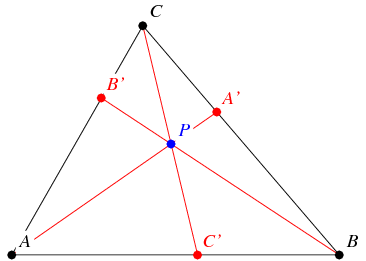 | ||
Math video definitions cevian geometry
In geometry, a cevian is any line segment in a triangle with one endpoint on a vertex of the triangle and the other endpoint on the opposite side. Medians, altitudes, and angle bisectors are special cases of cevians. The name cevian comes from the Italian engineer Giovanni Ceva, who proved a well-known theorem about cevians which also bears his name.
Contents
- Math video definitions cevian geometry
- Cevian capital s lars forberg on the nordic banking crisis of the 1990s
- Stewarts theorem
- Median
- Angle bisector
- Altitude
- Ratio properties
- Splitter
- Area bisectors
- Angle trisectors
- Area of inner triangle formed by cevians
- Literature
- References
Cevian capital s lars forberg on the nordic banking crisis of the 1990s
Stewart's theorem
The length of a cevian can be determined by Stewart's theorem: in the diagram, the cevian length d is given by the formula
Median
If the cevian happens to be a median (thus bisecting a side), its length can be determined from the formula
or
since
Hence in this case
Angle bisector
If the cevian happens to be an angle bisector, its length obeys the formulas
and
and
where the semiperimeter s = (a+b+c)/2.
The side of length a is divided in the proportion b:c.
Altitude
If the cevian happens to be an altitude and thus perpendicular to a side, its length obeys the formulas
and
where the semiperimeter s = (a+b+c) / 2.
Ratio properties
There are various properties of the ratios of lengths formed by three cevians all passing through the same arbitrary interior point: Referring to the diagram at right,
These last two properties are equivalent because summing the two equations gives the identity 1 + 1 + 1 = 3.
Splitter
A splitter of a triangle is a cevian that bisects the perimeter. The three splitters concur at the Nagel point of the triangle.
Area bisectors
Three of the area bisectors of a triangle are its medians, which connect the vertices to the opposite side midpoints. Thus a uniform-density triangle would in principle balance on a razor supporting any of the medians.
Angle trisectors
If from each vertex of a triangle two cevians are drawn so as to trisect the angle (divide it into three equal angles), then the six cevians intersect in pairs to form an equilateral triangle, called the Morley triangle.
Area of inner triangle formed by cevians
Routh's theorem determines the ratio of the area of a given triangle to that of a triangle formed by the pairwise intersections of three cevians, one from each vertex.
